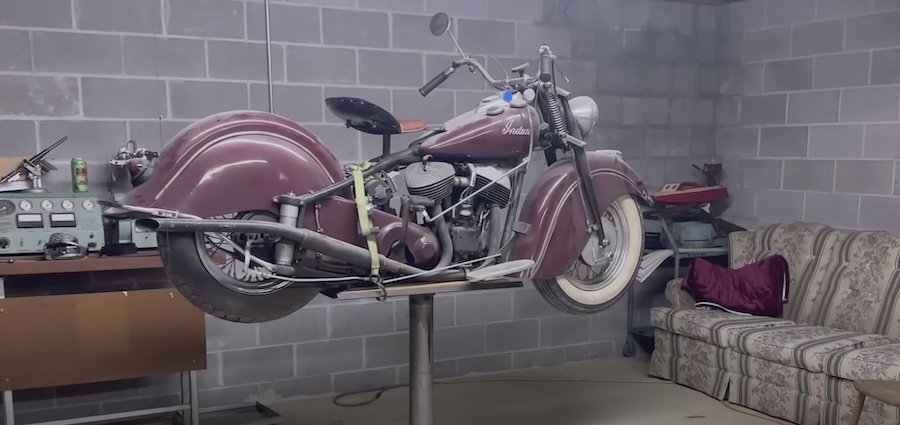1947 Indian Chief With 5,000 Original Miles Shows Why Classic Is Better

Still, it took the company over two decades before it got its first Chief. The model was added to the lineup in 1922 and has since established itself as the manufacturer’s staple model and its longest-production nameplate.
Founded by two bicycle racers, the Indian Motocycle Company (no R in the Moto-cycle) lived as an independent manufacturer until 1953, braving through some of the roughest times in American history of the past century. It powered the U.S. armed forces in both World Wars and was a successful name at racetracks.
When the heat of the second world war dissipated, and motoring reclaimed its pastime status, Indian began to stumble. Civilian production was resumed in 1946, but the success of yesteryears was gone. Even so, 1947 was the best year for Indian in almost three decades (at least, according to the scarce information gathered by historians from the few sources available).
Almost 12,000 units were assembled that year – the highest figure (available!) since 1919. Three trim models were available: the Clubman, the Sportsman, and the Roadmaster. One of those Chiefs assembled in 1947 has a neat story to tell – one that involves barn dust and half-a-century-old paint.
Here it goes: the vloggers from WD Detailing found a treasure trove of classic beauties, Chief among which stands this particular Mopar Maroon Sportsman. Assembled in 1947, the bike’s history is shady until 1970.
That’s when a rider walks into a bar, has a couple, then coughs up three Bennies (roughly $2,360 at the 2023 purchasing power) and buys a 1947 Indian from an equally enthusiastic fellow. The over-a-drink transaction, handshake-sealed at around 1:30 in the morning, saw the rider come into the possession of a genuine Indian Chief in a weird-looking shade of blue.
This last bit of information is conveyed by the current owner – and also the son of the 1970 rider – and it holds a degree of importance to this story. The color of this Chief is nowhere near the blue part of the rainbow spectrum.
Not happy with the chromatic of his newly-acquired machine, the owner paid a visit to the flea market, bought some paint, and resprayed the bike with this hue of cherry red you see in the video. That was in 1970, and the enthusiasm was probably greater than the actual needs. Of the seven quarts of Mopar Maroon paint, the Indian only consumed two to get a new coat.
However, a few years later, the rider also bought a sidecar for his Indian Chief Sportsman – but never got to install it to the bike. Fast-forward half a century, and the current owner (Brett, featured in the video), gives the sidecar a paint job. Using.The.Same.Cans.Of.Paint.From.1970!!!
If this little story doesn’t speak not just volumes but libraries about product quality, then perhaps this next bit does: the Indian – carefully stored on an in-ground motorcycle lift – proudly boasts a front whitewall tire from 1943. Not the model year; the actual manufacturing date of the rubber is 1943.
(Sidenote: For comparison, the rear tire – bought some three decades after the front one was produced – has cracks and signs of age. The whitewall Beck Frontrunner does not. Here’s one for you, every tire maker on Planet Piston: how many of your current products will be trustworthy in the year 2103?)
The Indian Chief Sportsman of 1947 was the middle-of-the-range offer, and it can be distinguished from the entry-level model by its chromed side mirror, handlebars, and wheel rims. The brochure in the gallery reveals more details about the Indian offer from that year; scroll and look.
After the customary wash, paint correction, deep cleaning, and conditioning, this solid-looking Chief finally gets its maiden voyage with the sidecar. Although it hasn’t been fired up in many years, the motorcycle was not neglected.
The big 74 CID V-twin (1,210 CCs) – factory-installed original – foot-cranks back to life after several attempts (play the video to see how riders of old did it). The engine, famous for its nearly-indestructible reliability, produced a hefty 38 hp for a three-speed manual transmission (again, fitted on the bike in ’47).
The ‘manual’ adjective literally means that the rider would shift gears via the tank-installed lever on the right side while simultaneously operating the clutch with the left foot. The 575-lbs (260 kg) Indian could cruise at 85 mph (137 kph). This Big Chief only has 5,259 miles (8,462 km) under its belt - quite the exquisite treat - which would largely explain the bike's overall good condition.
Apart from copious power, the rider was also treated with sleek looks – the massive, signature fenders with deep skirts (introduced in 1940), a new tubular-steel plunger frame, and a new front solid girder fork, inherited from the military models of the early 40s.
The fender design has been one of the most distinctive features of Indians, and all six of the brand’s revival models since 1953 have referred back to it. Atop the front fender, the 1947 Indian Chief had a new running light – encased in a war bonnet housing – and new scripting in metal on the tank.
Notícias Relacionadas
